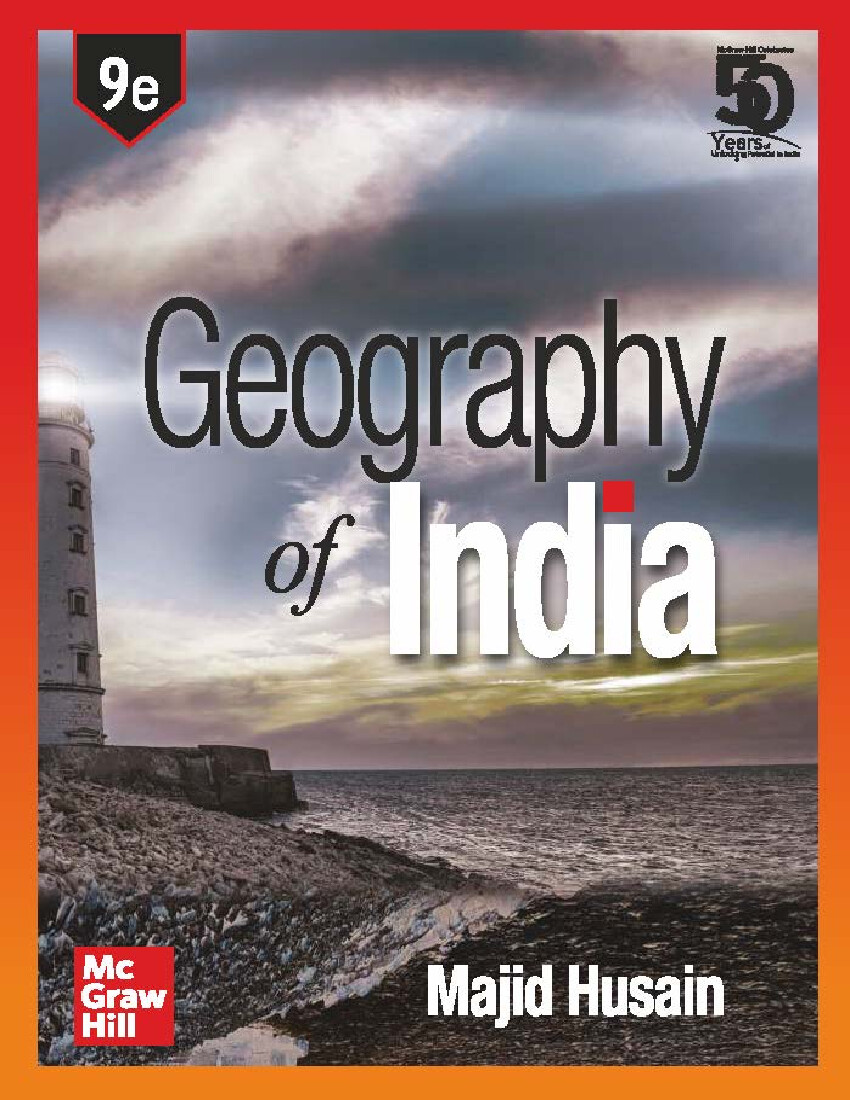
Geography of India (English Version) || McGraw Hill Education|| Author: Majid Husain || Full PDF Download
The book “Geography of India”, is written mainly for candidates preparing for competitive examinations. The flagship title is entering its 9th edition. The book is an established manual and a bestseller in the segment. It’s a widely read reference book that deals with relevant topics of India’s geographical landscape in a systematic and comprehensive manner. The book is updated with latest change in status of Jammu & Kashmir and Ladakh. All updates are inserted in the form of Maps, Data and statistics. Updated current events, especially to mention the Amphan Cyclone, COVID- 19 situation in India along with NRC, CAA, Vizag gas leak, Indo-China Issues, Locust menace and much more forms a part of this edition. Varied topics covered are Resources of India, different types of irrigation, cropping patterns of India, transport and public distribution system and food security, disasters and Government initiatives. It is also being increasingly referred to by graduates and postgraduates of the subject and by researchers and academicians.Salient Features:• Completely revised book with latest amendments in India’s Administrative boundary for the newly designated UT of Jammu and Kashmir and Ladakh.• Based on current UPSC syllabus, strong in theoretical concepts, supplemented with additional original maps and diagrams• Updated data and statistics• Revised chapters on current affairs with topics like Urban disasters, cyber-crime and social media.• Thoroughly revised content on Niti Ayog, Integrated watershed development programmes, Government schemes and initiatives, National New Mineral policy 2019• Thoroughly revised chapters on Regional Development and Planning, Agriculture, Minerals and Resources, Transport and Communication systems in India.• Content represented in form of mind maps, flowcharts, tabular format and statistical techniques for better understanding.
Note: Thank you for visiting our website. If you encounter payment difficulties, use UPI (bettersolutionforyou@icici) and email (bettersolutionforyou@gmail.com) us a payment screenshot. The purchased file will be emailed to you.

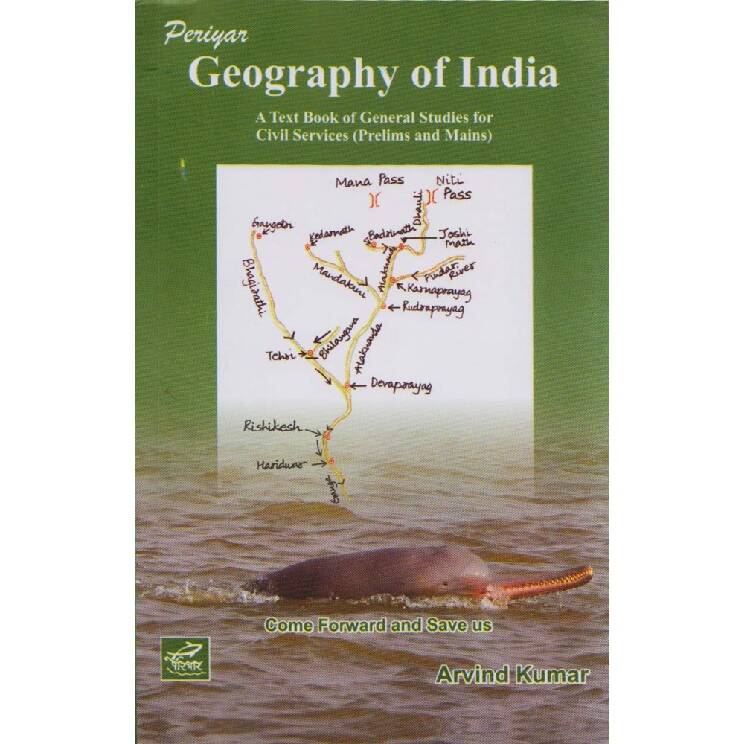
Geography Of India: A Text Book Of General Studies For Civil Services (English Version) || Periyar Prakashan || Author : Arvind Kumar || Full PDF Download
Geography Of India: A Text Book Of General Studies For Civil Services (English Version) || Periyar Prakashan || Author : Arvind Kumar
Very good book for any type exams like UPSC, State PSC, Bank, Rail etc. All maps are hand made. Written in Very easy language. If you Don’t have so much times to note then this book is very much helpful. You can easily complete this book with 15 days. Must go for it. After complete this book you realise you have completed 90 % of Syllabus except different states Geography.
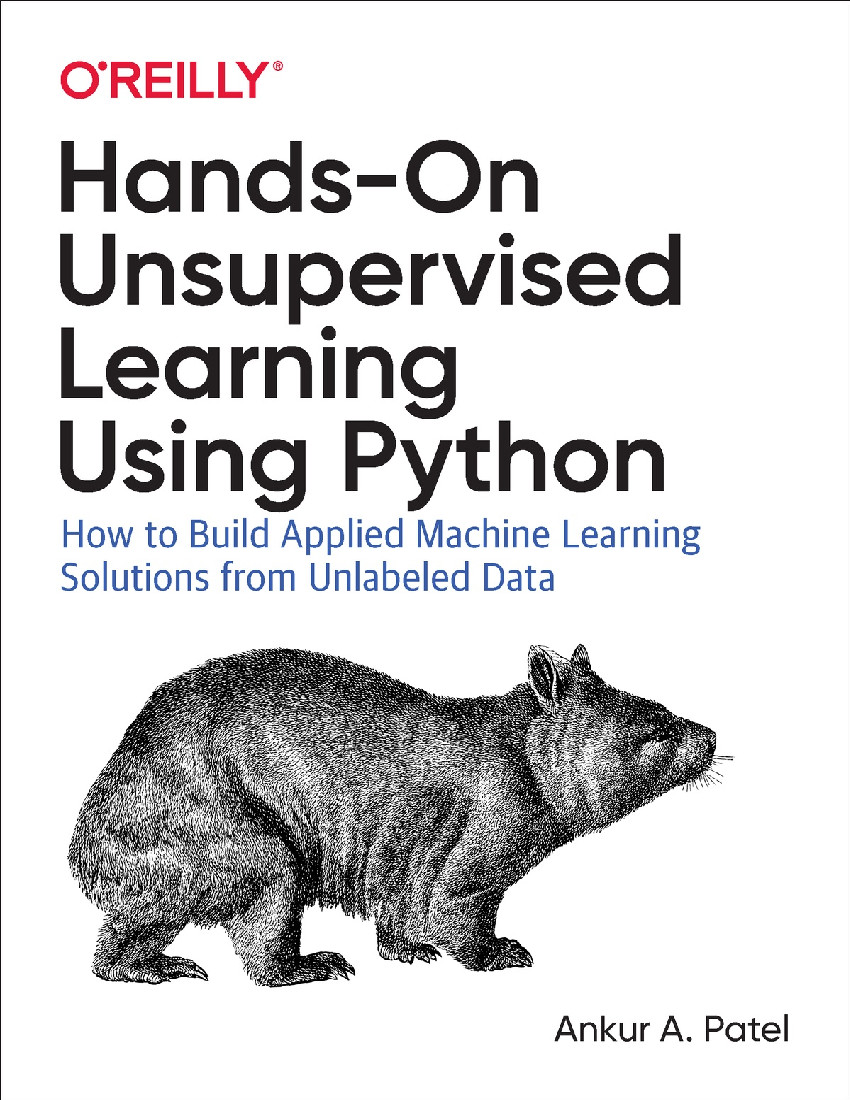
Hands-On Unsupervised Learning Using Python: How to Build Applied Machine Learning Solutions from Unlabeled Data by Ankur A Patel || Full PDF Download
Many industry experts consider unsupervised learning the next frontier in artificial intelligence, one that may hold the key to general artificial intelligence. Since the majority of the world’s data is unlabeled, conventional supervised learning cannot be applied. Unsupervised learning, on the other hand, can be applied to unlabeled datasets to discover meaningful patterns buried deep in the data, patterns that may be near impossible for humans to uncover.
Author Ankur Patel shows you how to apply unsupervised learning using two simple, production-ready Python frameworks: Scikit-learn and TensorFlow using Keras. With code and hands-on examples, data scientists will identify difficult-to-find patterns in data and gain deeper business insight, detect anomalies, perform automatic feature engineering and selection, and generate synthetic datasets. All you need is programming and some machine learning experience to get started.
* Compare the strengths and weaknesses of the different machine learning approaches: supervised, unsupervised, and reinforcement learning
* Set up and manage machine learning projects end-to-end
* Build an anomaly detection system to catch credit card fraud
* Clusters users into distinct and homogeneous groups
* Perform semisupervised learning
* Develop movie recommender systems using restricted Boltzmann machines
* Generate synthetic images using generative adversarial networks
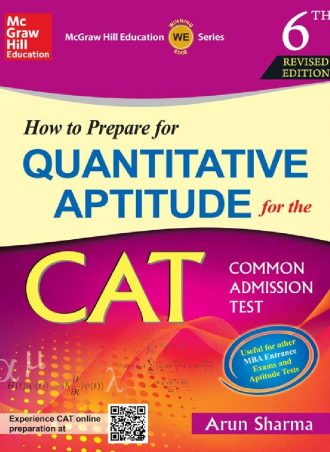
How to Prepare for Quantitative Aptitude for the CAT (6th Ed, 2014) McGraw-Hill Education (India) by Arun Sharma
A bestselling preparatory guide book on quantitative aptitude for Common Entrance Test or CAT, Quantitative Aptitude for CAT is essentially based on the current CAT syllabus and covers all the recent trends and patterns of the examination. Not just CAT, the book has found favourable readers among other candidates appearing for professional examinations such as XAT, MAT, IIFT, SNAP, etc.
Quantitative aptitude is one of the most important and difficult portion of the CAT examinations, which this book attempts to address. It broadly covers all the formats that have been appearing in past years question papers, is learning friendly and has a scientific approach to it. In the many topics put together, the concepts, the reasoning and the resulting answers have all be explained by way of examples, where ever possible and by illustrations and graphs, where required.
There book has been divided into six sections, which are: Numbers, Averages and Mixtures, Arithmetic and Word-based problems, Geometry, Algebra and Counting. These sections have further been broken down chapters and exercises related to the section.
However, to assist the students converging from varied academic backgrounds to cope up with the syllabus easily, the book has a ready reckoner section titled, ‘First Things First’ right at the start which discusses elementary concepts chapters, like Addition and Subtractions, Multiplications, Division, Ratio and Proportions, Percentage calculations and square roots and cubes.
At the end of each section and chapter there are practice exercises and model test papers that help one to do a self evaluation about the preparedness level achieved. The book also includes ‘Solved Papers’ that enable students to understand how the questions can be solved within the allotted timeframe.
Last but not the least, question papers of IIFT 2013, XAT 2014 and SNAP 2011 are also there in the book for the benefit of the students. This is the 6th edition of the book that was published on May, 2014 by Mcgraw Hill Education publishers.
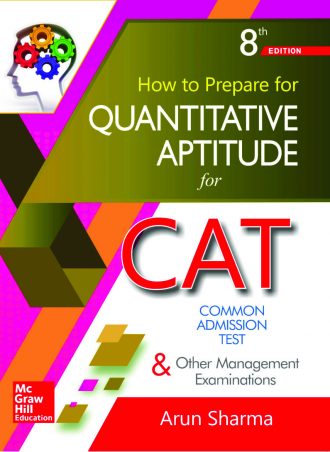
How to Prepare for Quantitative Aptitude for the CAT (8th Ed, 2018) McGraw-Hill Education (India) by Arun Sharma (Copy)
A bestselling preparatory guide book on quantitative aptitude for Common Entrance Test or CAT, Quantitative Aptitude for CAT is essentially based on the current CAT syllabus and covers all the recent trends and patterns of the examination. Not just CAT, the book has found favourable readers among other candidates appearing for professional examinations such as XAT, MAT, IIFT, SNAP, etc.
Quantitative aptitude is one of the most important and difficult portion of the CAT examinations, which this book attempts to address. It broadly covers all the formats that have been appearing in past years question papers, is learning friendly and has a scientific approach to it. In the many topics put together, the concepts, the reasoning and the resulting answers have all be explained by way of examples, where ever possible and by illustrations and graphs, where required.
There book has been divided into six sections, which are: Numbers, Averages and Mixtures, Arithmetic and Word-based problems, Geometry, Algebra and Counting. These sections have further been broken down chapters and exercises related to the section.
However, to assist the students converging from varied academic backgrounds to cope up with the syllabus easily, the book has a ready reckoner section titled, ‘First Things First’ right at the start which discusses elementary concepts chapters, like Addition and Subtractions, Multiplications, Division, Ratio and Proportions, Percentage calculations and square roots and cubes.
At the end of each section and chapter there are practice exercises and model test papers that help one to do a self evaluation about the preparedness level achieved. The book also includes ‘Solved Papers’ that enable students to understand how the questions can be solved within the allotted timeframe.
Last but not the least, question papers of IIFT 2013, XAT 2014 and SNAP 2011 are also there in the book for the benefit of the students. This is the 6th edition of the book that was published on May, 2014 by Mcgraw Hill Education publishers.
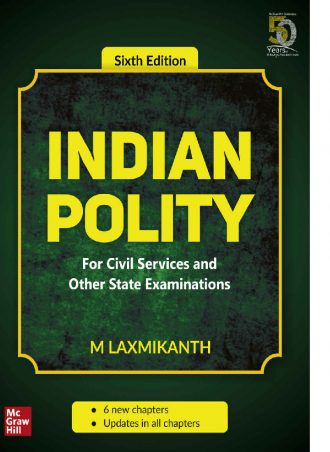
Indian Polity – For Civil Services and Other Competitive Examinations-McGraw Hill Education (India) (6th Ed. 2020) by M. Laxmikanth
The book “Indian Polity”, 6th edition is a must-read for the aspirants appearing for the Civil Services Examinations as well as the other state Services Examinations. It is conceived to cater to the requirements of not just students appearing for competitive examinations but also postgraduates, research scholars, academics and General readers who are interested in the country political, Civil and constitutional issues. The extant chapters have been thoroughly revised and updated as per the recent developments. ✔ 80 chapters and 16 appendices covering the entire Indian political and constitutional spectrum
✔ chapters rearranged as per the latest pattern of the examination
✔ coverage on the recent developments in Jammu & Kashmir and Ladakh, constitutional interpretation, judicial review and judicial activism
✔ updated previous years’ questions and revised practice questions for both Preliminary and Mains Examinations
✔ one-stop reference for the Civil Services aspirants, students of law, political Science and public Administration
✔ 6 New chapters:
Goods and Services Tax Council
National Commission for backward classes
National investigation agency
National disaster Management
role of regional parties
coalition government.
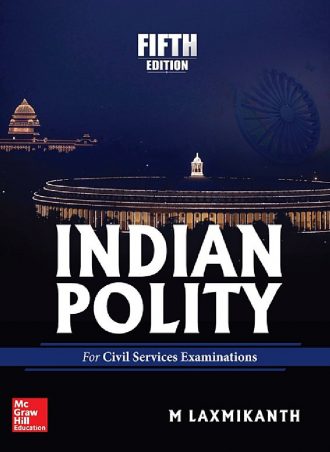
Indian Polity- For Civil Services and Other Competitive Examinations-McGraw Hill Education (India) (5th Ed. 2017) by M. Laxmikanth
McGraw Hill is proud to present the fifth edition of Indian Polity by M Laxmikanth. The book itself needs no introduction. It is one of the most popular and comprehensive books on the subject and has been a consistent bestseller for many years. It has become a must-read book for aspirants appearing in various competitive examinations, especially the civil services examinations. The wide range and scope of issues that it covers also makes it valuable to postgraduates, research scholars, academics and general readers who are interested in the country’s political, civil and constitutional issues. This new, fifth edition, has seven new chapters added, along with four new appendices. The extant chapters have been completely revised and updated with recent developments.
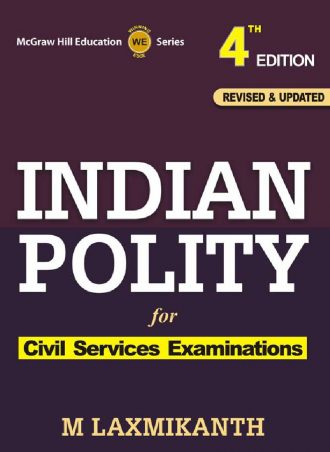
Indian Polity-McGraw Hill Education (India) Private Limited (4th Ed. 2013) by M. Laxmikanth
This book has been specifically designed to meet the academic needs of the civil services’ aspirants. With this handy resource, a reader can gain perspective on numerous features of the political system in the country as well as the trends.
Divided into as many as 11 parts, the part one of the Indian Polity focuses on Indian constitutional framework while the part two sheds light on the system of the Government of India. The next three parts of the book provide details about the Central, State and Local Governments and their individual ways of governing while the sixth and seventh parts deal with the Constitutional Bodies and UTs of the India Union. Detailed information on non-constitutional bodies, other constitutional dimensions and working of the Indian constitution have been covered in rest of the parts.
Written in easy and clear language, Indian Polity’s appendices include A-Z aspects of Indian politics including but not limited to articles of the constitution, constitutional amendments, ministries and departments of the central government.
Apart from the detailed information concerning the various aspects of Indian politics, the book has a total of 71 chapters with 14 appendices. All chapters in the book are supplemented by a set of probable questions at the end. Those appearing for Civil Services Examinations can practice with these questions after having gone through the contents. Although primarily referred to as a good resource for those preparing for above mentioned examinations, the book has also been used extensively by the students of Law.
In short, the book provides a birds’ eye view of numerous components of the Indian political system and the government. After having read the book, an aspirant may be able to go into the details of different topics separately. Available in paperback edition, it is published by Tata McGraw-Hill Education. The fourth edition of this book by M Laxmikanth was published on July 1st, 2013.